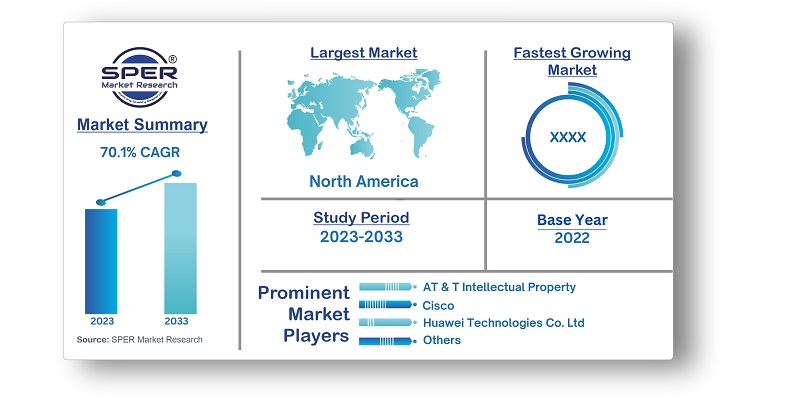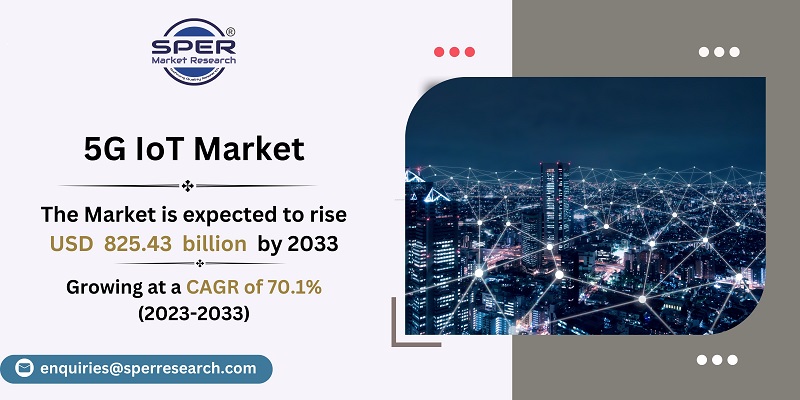
5G IoT Market Growth, Size, Trends, Demand, Revenue, Share, Competition and Future Outlook
Global 5G IoT Market Size- By Component, By Enterprise Size, By Network Type, By End User- Regional Outlook, Competitive Strategies and Segment Forecast to 2033
| Published: Jan-2024 | Report ID: IACT2406 | Pages: 1 - 227 | Formats*: |
| Category : Information & Communications Technology | |||
- January 2022: Verizon and Atos collaborated to power intelligent IoT solutions for consumers with private 5G multi-access edge computing. The 5G edge solution will change the way businesses influence predictive analytics. The solution will allow them to improve operational efficiency, reduce risk, and increase revenue.
- November 2022: T Mobile, Cradle point, and Bosch cooperated to use 5G Wireless WAN technology to provide advanced IoT connectivity solutions such as autonomous vehicles, robots, and AR/VR.


| Report Metric | Details |
| Market size available for years | 2019-2033 |
| Base year considered | 2022 |
| Forecast period | 2023-2033 |
| Segments covered | By Component, By Enterprise size, By Network Type, By End User. |
| Regions covered | North America, Asia-Pacific, Latin America, Middle East & Africa and Europe |
| Companies Covered | AT & T Intellectual Property, Cisco, Huawei Technologies Co. Ltd., Intel Technology., NEC Corporation, Nokia, Qualcomm Technologies, Inc., Samsung Electronics Co. Ltd., Telefonaktiebolaget LM Ericsson, ZTE Corporation. |
- Manufacturing Industry
- Automotive Industry
- Telecommunication Providers
- Logistics and warehousing
- Technology and IT Companies
| By Component: |
|
| By Enterprise size: |
|
| By Network Type: |
|
| By End User: |
|
- Global 5G IoT Market Size (FY’2023-FY’2033)
- Overview of Global 5G IoT Market
- Segmentation of Global 5G IoT Market By Component (Services, Solution)
- Segmentation of Global 5G IoT Market By Enterprise Size (Large Enterprises, Small & Medium Sized Enterprises)
- Segmentation of Global 5G IoT Market By Network Type (5G NR Non-standalone architecture, 5G NR Standalone Architecture)
- Segmentation of Global 5G IoT Market By End User (Agriculture, Energy & utilities, Government & Public Safety, Healthcare, Manufacturing, Transportation & Logistics, Others)
- Statistical Snap of Global 5G IoT Market
- Expansion Analysis of Global 5G IoT Market
- Problems and Obstacles in Global 5G IoT Market
- Competitive Landscape in the Global 5G IoT Market
- Impact of COVID-19 and Demonetization on Global 5G IoT Market
- Details on Current Investment in Global 5G IoT Market
- Competitive Analysis of Global 5G IoT Market
- Prominent Players in the Global 5G IoT Market
- SWOT Analysis of Global 5G IoT Market
- Global 5G IoT Market Future Outlook and Projections (FY’2023-FY’2033)
- Recommendations from Analyst
1.1. Scope of the report1.2. Market segment analysis
2.1. Research data source2.1.1. Secondary Data2.1.2. Primary Data2.1.3. SPER’s internal database2.1.4. Premium insight from KOL’s2.2. Market size estimation2.2.1. Top-down and Bottom-up approach2.3. Data triangulation
4.1. Driver, Restraint, Opportunity and Challenges analysis4.1.1. Drivers4.1.2. Restraints4.1.3. Opportunities4.1.4. Challenges
4.2. COVID-19 Impacts of the Global 5G IoT Market
5.1. SWOT Analysis5.1.1. Strengths5.1.2. Weaknesses5.1.3. Opportunities5.1.4. Threats5.2. PESTEL Analysis5.2.1. Political Landscape5.2.2. Economic Landscape5.2.3. Social Landscape5.2.4. Technological Landscape5.2.5. Environmental Landscape5.2.6. Legal Landscape5.3. PORTER’s Five Forces5.3.1. Bargaining power of suppliers5.3.2. Bargaining power of buyers5.3.3. Threat of Substitute5.3.4. Threat of new entrant5.3.5. Competitive rivalry5.4. Heat Map Analysis
6.1. Global 5G IoT Market Manufacturing Base Distribution, Sales Area, Product Type6.2. Mergers & Acquisitions, Partnerships, Product Launch, and Collaboration in Global 5G IoT Market
7.1. Global 5G IoT Market Value Share and Forecast, By Component, 2023-20337.2. Services7.3. Solution7.3.1. Hardware7.3.2. Software & Platform
8.1. Global 5G IoT Market Value Share and Forecast, By Enterprise Size, 2023-20338.2. Large Enterprises8.3. Small & Medium Sized Enterprises
9.1. Global 5G IoT Market Value Share and Forecast, By Network Type, 2023-20339.2. 5G NR Non-standalone architecture9.3. 5G NR Standalone Architecture
10.1. Global 5G IoT Market Value Share and Forecast, By End User, 2023-203310.2. Agriculture10.3. Energy & utilities10.4. Government & Public Safety10.5. Healthcare10.6. Manufacturing10.7. Transportation & Logistics10.8. Others
11.1. Global 5G IoT Market Size and Market Share
12.1. Global 5G IoT Market Size and Market Share By Component (2019-2026)12.2. Global 5G IoT Market Size and Market Share By Component (2027-2033)
13.1. Global 5G IoT Market Size and Market Share By Enterprise Size (2019-2026)13.2. Global 5G IoT Market Size and Market Share By Enterprise Size (2027-2033)
14.1. Global 5G IoT Market Size and Market Share By Network Type (2019-2026)14.2. Global 5G IoT Market Size and Market Share By Network Type (2027-2033)
15.1. Global 5G IoT Market Size and Market Share By End User (2019-2026)15.2. Global 5G IoT Market Size and Market Share By End User (2027-2033)
16.2. Global 5G IoT Market Size and Market Share By Region (2027-2033) 16.3. Asia-Pacific16.1. Global 5G IoT Market Size and Market Share By Region (2019-2026)
16.3.1. Australia16.3.2. China16.3.3. India16.3.4. Japan16.3.5. South Korea16.3.6. Rest of Asia-Pacific16.4. Europe16.4.1. France16.4.2. Germany16.4.3. Italy16.4.4. Spain16.4.5. United Kingdom16.4.6. Rest of Europe16.5. Middle East and Africa16.5.1. Kingdom of Saudi Arabia16.5.2. United Arab Emirates16.5.3. Rest of Middle East & Africa16.6. North America16.6.1. Canada16.6.2. Mexico16.6.3. United States16.7. Latin America16.7.1. Argentina16.7.2. Brazil16.7.3. Rest of Latin America
17.1. AT & T Intellectual Property17.1.1. Company details17.1.2. Financial outlook17.1.3. Product summary17.1.4. Recent developments17.2. Cisco17.2.1. Company details17.2.2. Financial outlook17.2.3. Product summary17.2.4. Recent developments17.3. Huawei Technologies Co. Ltd.17.3.1. Company details17.3.2. Financial outlook17.3.3. Product summary17.3.4. Recent developments17.4. Intel Technology17.4.1. Company details17.4.2. Financial outlook17.4.3. Product summary17.4.4. Recent developments17.5. NEC Corporation17.5.1. Company details17.5.2. Financial outlook17.5.3. Product summary17.5.4. Recent developments17.6. Nokia17.6.1. Company details17.6.2. Financial outlook17.6.3. Product summary17.6.4. Recent developments17.7. Qualcomm Technologies, Inc.17.7.1. Company details17.7.2. Financial outlook17.7.3. Product summary17.7.4. Recent developments17.8. Samsung Electronics Co. Ltd.17.8.1. Company details17.8.2. Financial outlook17.8.3. Product summary17.8.4. Recent developments17.9. Telefonaktiebolaget LM Ericsson17.9.1. Company details17.9.2. Financial outlook17.9.3. Product summary17.9.4. Recent developments17.10. ZTE Corporation17.10.1. Company details17.10.2. Financial outlook17.10.3. Product summary17.10.4. Recent developments17.11. Others
SPER Market Research’s methodology uses great emphasis on primary research to ensure that the market intelligence insights are up to date, reliable and accurate. Primary interviews are done with players involved in each phase of a supply chain to analyze the market forecasting. The secondary research method is used to help you fully understand how the future markets and the spending patterns look likes.
The report is based on in-depth qualitative and quantitative analysis of the Product Market. The quantitative analysis involves the application of various projection and sampling techniques. The qualitative analysis involves primary interviews, surveys, and vendor briefings. The data gathered as a result of these processes are validated through experts opinion. Our research methodology entails an ideal mixture of primary and secondary initiatives.



Frequently Asked Questions About This Report
PLACE AN ORDER
Year End Discount
Sample Report
Pre-Purchase Inquiry
NEED CUSTOMIZATION?
Request CustomizationCALL OR EMAIL US
100% Secure Payment






Related Reports
Our Global Clients
Our data-driven insights have influenced the strategy of 200+ reputed companies across the globe.




















